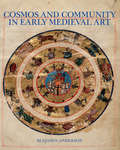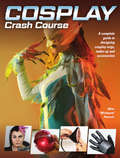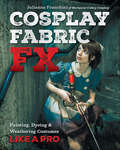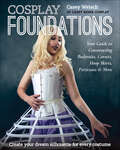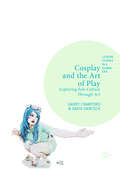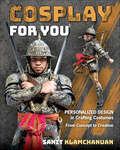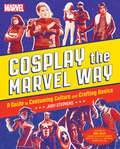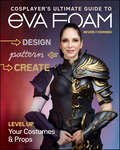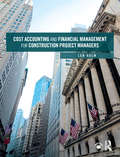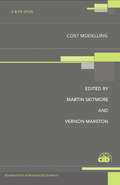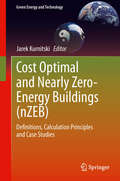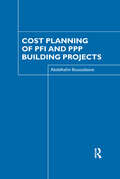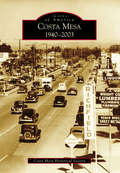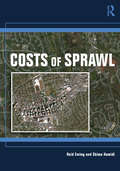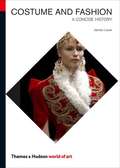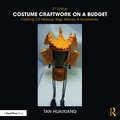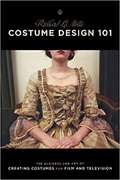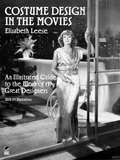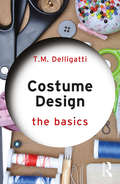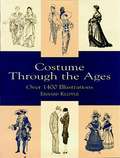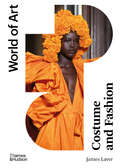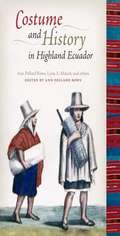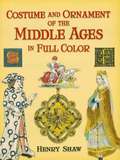- Table View
- List View
Cosmos and Community in Early Medieval Art
by Benjamin AndersonIn the rapidly changing world of the early Middle Ages, depictions of the cosmos represented a consistent point of reference across the three dominant states--the Frankish, Byzantine, and Islamic Empires. As these empires diverged from their Greco-Roman roots between 700 and 1000 A. D. and established distinctive medieval artistic traditions, cosmic imagery created a web of visual continuity, though local meanings of these images varied greatly. Benjamin Anderson uses thrones, tables, mantles, frescoes, and manuscripts to show how cosmological motifs informed relationships between individuals, especially the ruling elite, and communities, demonstrating how domestic and global politics informed the production and reception of these depictions. The first book to consider such imagery across the dramatically diverse cultures of Western Europe, Byzantium, and the Islamic Middle East, Cosmos and Community in Early Medieval Art illuminates the distinctions between the cosmological art of these three cultural spheres, and reasserts the centrality of astronomical imagery to the study of art history.
Cosplay Crash Course: A Complete Guide to Designing Cosplay Wigs, Makeup and Accessories
by Mina PetrovicCosplay lets you step out of your own skin and into someone else's shoes (or boots, or paws...). This beginner's guide helps you walk that walk with confidence in an awesome costume of your own creation. True to the cosplay spirit of collaboration, Cosplay Crash Course shares favorite tricks and techniques from some of the community's most imaginative artists. Step by step, you'll learn how to turn ordinary fabrics, inexpensive toys, easy-to-manipulate thermoplastics, wigs and other humble materials into original costumes you'll wear with pride. Whether you're making fabulous feathers, metallic armor, wicked horns, lifelike claws or form-fitting boots, this book puts it all within your reach. You'll even learn awesome hair and makeup effects to complete the look. Use this inside advice to fast-forward through years of trial and error; learn to select the best fabrics and adhesives and to make practical choices for comfort and wearability. Armed with the know-how in these pages and a spirit of adventure, who will you become? Everything you need to dress your part!25+ step-by-step projects for creating authentic-looking props, costumes and accessoriesEasy techniques and clever shortcuts from nine international cosplay artistsHow to manipulate wigs, extensions and your own hair to create unique and expressive looksAwesome makeup effects, from tattoos and zombie bites to tricks for making faces appear more feminine or masculineBonus tips for striking a pose and snapping dynamic, in-character photos
Cosplay Fabric FX: Painting, Dyeing & Weathering Costumes Like a Pro
by Julianna FranchiniElevate your costume-making skills to the next level! Getting exactly the look you want and achieving knock-out special effects can be as simple as weathering or painting on fabric, but strategically damaging or adding paint to your costume can be intimidating - what if you get it wrong?! Many cosplayers are adept at sewing up costumes but have no idea how to add details and effects that help tell a story. Marquise Cubey (Juliana Franchini), a veteran cosplayer and industry expert, demystifies paint, tools, and techniques to help you add fabric painting and weathering to your arsenal of costume effects! Learn how to manipulate paint on fabric and add weathering to your arsenal of costume effects Create special effects like metal, dirt, burns, blood, wear and tear, and rust, plus shading techniques, with detailed how-to instructions Enhance your tiny details and give your props and costumes more dimension than ever
Cosplay Foundations: Your Guide to Constructing Bodysuits, Corsets, Hoop Skirts, Petticoats & More (Costume Effects)
by Casey WelschFrom armor to anime! Sew a whole closet of foundation garments fitted just for you with expert guidance from the founder of Casey Renee Cosplay.Don’t let your costumes fall flat! Give them the support they need and get the right fit every time with Cosplay Foundations. You’ll learn to create a capsule wardrobe of foundation garments, including corsets, petticoats, bodysuits, hoops, crinolines, leggings, and more. Sew the perfect silhouette for any costume, from historical gowns to structured armor and anime builds with multi-award-winning cosplayer Casey Welsch. This visual guide includes more than 400 step-by-step photos, patterns, and all the inspiration you need to give your garments a professional look that lasts with well-made foundations. And you’ll add longevity to your costumes with undergarments that protect them from perspiration and wear and tear.
Cosplay World
by Brian Ashcraft Luke PlunkettFor over 100 years, men and women around the world have been dressing up as their favourite characters from movies, games, comics, TV, and books. Beginning as a curiosity and hobby for social outcasts, it's now a global phenomenon, fuelled by the Internet and an explosion in geek fandom. This in-depth look at the world of cosplay includes interviews with stars like Yaya Han, Crystal Graziano, and Spiral Cats, offers insights into cosplay's history and current landscape, and explains its creative processes, like how Megan Marie built the perfect Wonder Woman costume. Cosplay World features over 200 compelling photographs, showcasing everything from campy 1970s costumes to cutting-edge suits engineered in workshops and built using space-age materials. The result is both a celebration of and an informed look at a popular means of self-expression that continues to fascinate. AUTHOR: Brian Ashcraft is Senior Contributing Editor for the video game site Kotaku, an arm of Gawker.com. He is the author of Arcade Mania! and Japanese Schoolgirl Confidential. Luke Plunkett is Contributing Editor for Kotaku. He is based in Canberra, Australia. 225 colour illustrations
Cosplay and the Art of Play: Exploring Sub-Culture Through Art (Leisure Studies in a Global Era)
by David Hancock Garry CrawfordThis book is an introduction to cosplay as a subculture and community, built around playful spaces and the everyday practices of crafting costumes, identities, and performances. Drawing on new and original ethnographic data, as well as the innovative use of arts-led research, this book adds to our understanding of a popular, global cultural practice. In turn, this pushes forward our understanding of play, fan practices, subcultures, practice-led research, and uses of urban spaces. Cosplay and the Art of Play offers a significant addition to key contemporary debates on the meaning and uses of popular culture in the 21st century, and will be of importance to students and scholars interested in communities, fandom, identity, leisure, participatory cultures, performance, and play.
Cosplay for You: Personalized Design in Crafting Costumes; From Concept to Creation
by Sanit KlamchanuanReflect your personality through larger-than-life cosplay that pairs fashion and function. Wellington-based costume designer Sanit Klamchanuan, a contractor with Weta Workshop, teaches you to build cosplay from scratch or remix popular characters. Follow Sanit’s complete design process through five original cosplays—from planning to problem-solving to execution. Learn how every costume can be made more comfortable, easier to pack for shows, and more impressive to behold! Find inspiration and personalize your build for a striking finished product that’s truly your own.
Cosplay the Marvel Way: A Guide to Costuming Culture and Crafting Basics
by Judith StephensThe cosplay producer and co-creator of the Women Of Marvel podcast weaves together the history of Marvel cosplay with practical tips, advice, and instructions on how-to create your own cosplays based on popular Marvel heroes Black Panther, Captain America, Ms. Marvel, Ironheart, Phoenix, and Loki. An officially licensed guide to learning about and creating Marvel cosplays, Cosplay the Marvel Way walks readers through every step of the creative process—from choosing a character, gathering your materials and tools, building your cosplay using items in your closet or from the thrift store, and showing off their new look at a convention or photoshoot. Whether you are just starting out or have a whole closet jam-packed with amazing cosplays, this book is perfect for anyone Marvel fans that are interested in or love dressing up as their favorite super heroes. Cosplay the Marvel Way is a reminder that cosplay is more than making and putting on a costume–it&’s about community, about finding who you are, and expressing it through the intersection of comics and fashion.
Cosplayer's Ultimate Guide to EVA Foam: Level Up Your Costumes & Props
by Beverly DownenUnlock the unlimited possibilities of EVA foam! Turn your wildest costume dreams into reality! Whether you are a master-level cosplayer or brand-new to making costumes and props, this is the ultimate reference guide to using different kinds of EVA foam and other up-to-date materials and to make epic costumes, props, accessories, and other projects out of this world! If you want to create your own high quality props, EVA foam is the way to go — it is a rubber-like thermoplastic that is both easy to work with, durable, and lightweight. You can build an entire costume with EVA foam — shields, armor, helmet, weapons — without getting weighed down. Knowledge at your fingertips! This comprehensive guidebook - take it with you to shop for materials, write notes and bookmark your favorite chapters, and use it right at your workstation Expand your cosplay skills with the latest industry techniques and materials, step-by-step tutorials, and 4 projects to get you started Create patterns for perfectly fitting costumes and accessories every time and use the patterns included to guide the way
Cost Accounting and Financial Management for Construction Project Managers
by Len HolmProper cost accounting and financial management are essential elements of any successful construction job, and therefore make up essential skills for construction project managers and project engineers. Many textbooks on the market focus on the theoretical principles of accounting and finance required for head office staff like the chief financial officer (CFO) of a construction firm. This book's unique practical approach focuses on the activities of the construction management team, including the project manager, superintendent, project engineer, and jobsite cost engineers and cost accountants. In short, this book provides a seamless connection between cost accounting and construction project management from the construction management practitioner’s perspective. Following a complete accounting cycle, from the original estimate through cost controls to financial close-out, the book makes use of one commercial construction project case study throughout. It covers key topics like financial statements, ratios, cost control, earned value, equipment depreciation, cash flow, and pay requests. But unlike other texts, this book also covers additional financial responsibilities such as cost estimates, change orders, and project close-out. Also included are more advanced accounting and financial topics such as supply chain management, activity-based accounting, lean construction techniques, taxes, and the developer’s pro forma. Each chapter contains review questions and applied exercises and the book is supplemented with an eResource with instructor manual, estimates and schedules, further cases and figures from the book. This textbook is ideal for use in all cost accounting and financial management classes on both undergraduate and graduate level construction management or construction engineering programs.
Cost Modelling
by Martin Skitmore Vernon MarstonCost models underlie all the techniques used in construction cost and price forecasting, yet until relatively recently industry has been unfamiliar with their characteristics and properties. An understanding of the various types of cost model is vital to enable effective cost control and the development of future forecasting techniques.This volume brings together more than 20 seminal contributions to building cost modelling and introduces the major landmarks in progress and thinking in this field:* strategies and directions* explorations in cost modelling* cost-product/process modelling* dealing with uncertaintyThe strong techniques bias of this book will appeal to construction professionals involved in estimating, as well as researchers and students of building economics.
Cost Optimal and Nearly Zero-Energy Buildings: Definitions, Calculation Principles and Case Studies (Green Energy and Technology)
by Jarek KurnitskiCost optimal and nearly zero energy performance levels are principles initiated by the European Union's (EU) Energy Performance of Buildings Directive which was recast in 2010. These will be major drivers in the construction sector in the next few years, because all new buildings in the EU from 2021 onwards are expected to be nearly zero energy buildings (nZEB). This book introduces the technical definitions, system boundaries, energy calculation methodology and input data needed to set primary energy based minimum/cost optimal and nZEB requirements in national energy frames. Worked examples are provided to illustrate the calculation of delivered, exported and primary energy, and renewable energy contribution. Five case studies of high performance nZEB office buildings across Europe are reported to show alternative technical solutions and to draw some general design rules based on completed nZEB buildings. Specific features of the nZEB design process, especially in the early stages, and architectural competitions are included. These describe important design issues in the scoping and conceptual design phase, allowing design streams to be controlled so that specified targets can be met. This book is intended for readers who need to be aware of or are working with the energy performance of buildings - for decision makers in public and private sectors, architects, engineers, construction clients, consultants, contractors, manufacturers and students. The editor of this book, Professor Jarek Kurnitski has made major contributions to the preparation of the European REHVA nZEB technical definition and has developed energy calculation frames for current Estonian and Finnish energy performance regulations. He is the leader of nZEB research at Tallinn University of Technology in Estonia and Aalto University in Finland, and he has over 300 publications.
Cost Planning of PFI and PPP Building Projects
by Abdelhalim BoussabaineThis topical and timely book presents and innovative approach to dealing with the complexities of cost planning in PFI. PFI/PPP projects have a significantly different costing environment from conventionally procured projects, requiring cost analysts to use their expertise and innovative thinking to develop whole-life cost solutions that deliver value for money to the client, thus improving public building assets performance. Abdelhalim Boussabaine provides a thorough grounding in the theory of PFI, from its early evolution through to examples of current projects. In particular, the rationale for private financing of public services, arguments for and against PFI and 'value for money' mechanisms are discussed. The book presents an innovative framework for whole-life value and calls for changes in the way whole life cycle value is perceived, created and exchanged. Cost Planning of PFI and PPP Building Projects provides the reader with existing knowledge as well as present innovative thinking for future development and management of PFI/PPP cost planning processes. Given the importance and novelty of this book, academics, professionals, undergraduate and postgraduate students will find this book valuable.
Costa Mesa: 1940-2003 (Images of America)
by Costa Mesa Historical SocietyPerhaps no one could have foreseen the amazing transformation of Costa Mesa from a sleepy rancho to today's bustling "City of the Arts." Along with other Orange County cities, Costa Mesa experienced explosive growth, redevelopment, county bankruptcy, traffic, and environmental issues. While navigating these events, Costa Mesa emerged with its own brand of Southern California cityhood. World War II brought the Santa Ana Army Air Base (SAAAB) to town, along with 125,000 cadets. Postwar SAAAB conversion established the Orange County Fairgrounds, colleges, and housing. After incorporation in 1953, the race was on to achieve critical mass while surrounded by older, established cities. The Segerstrom family led the way to world-class facilities, such as South Coast Plaza and the Orange County Performing Arts Center. These venues shifted the city center from the traditional downtown to north Costa Mesa. Located at the confluence of three freeways and adjacent to John Wayne-Orange County Airport, Costa Mesa faces the future as the center of the South Coast Metro complex.
Costs of Sprawl
by Reid Ewing Shima HamidiAcross the nation, the debate over metropolitan sprawl and its impact has become pivotal to urban planning. A decade and a half ago, Smart Growth America and the U.S. Environmental Protection Agency sought to raise the level of the debate by sponsoring groundbreaking research to quantitatively measure sprawl and its quality-of-life impacts. The resulting measures are widely used in urban research and public health. Costs of Sprawl provides a panoramic guide to urban form in America, measures sprawl for metropolitan areas, urbanized areas, and counties, and studies the relationship between sprawl and quality-of-life outcomes. From this preliminary investigation, it looks like the costs of sprawl are varied and substantial, and the alternative of compact development is far superior. An essential read for researchers, planners, urban designers, policy makers, and smart growth advocates in the U.S. and abroad, this book provides a comprehensive and detailed analysis of one of the most critical issues in planning today.
Costume And Fashion: A Concise History
by James Laver Amy de la HayeThe new fifth edition of this classic guide to clothing throughout history now extends into the second decade of the 21st century. James Laver's classic study of clothing, from the invention of the needle to the dawn of denim, neolithic weavers to catwalk creations, has been updated once again to cover the latest trends, from vintage to high street chic and the spectacular reinvention of haute couture. Featuring designers such as Alexander McQueen and Marc Jacobs, and style leaders Kate Moss and the Duchess of Cambridge, a new final chapter explains the forces shaping fashion today, including Internet technology, celebrity influence, 'fast fashion', the recession and global markets. With eight new pages, six new illustrations and an entirely new final chapter, this book reclaims its position as the definitive concise history of the subject, and remains essential reading for all students of art, costume and fashion.
Costume Construction (2nd Edition)
by Katherine Strand-EvansThis invaluable reference book leads the reader, step by step, through the stages of costume construction: from shop organization, pattern development, fabric selection and modification, to the more specific construction techniques for shoes, hats, masks, armor, and jewelry. It is intended for painters, pattern makers, drapers, artists, sculptors, milliners, seamsters, as well as those who enjoy handwork. Readers will learn not only the basic skills of sewing, drafting, draping, and millinary, but also all the techniques necessary for a successful career in the exciting world of costume crafts. Among its outstanding features, Costume Construction includes: (1) more than 300 illustrations, charts, and diagrams; (2) a comprehensive section on costume maintenance and storage; and (3) practical exercises at the end of each chapter.
Costume Craftwork on a Budget: Clothing, 3-D Makeup, Wigs, Millinery & Accessories
by Tan HuaixiangCostume Craftwork on a Budget demonstrates how to use inexpensive materials to create durable costumes and props in a short amount of time. Fully illustrated step-by-step instructions teach readers how to use 3-D makeup and create teeth, wigs, masks, hats, nonhuman costumes, leather products, and other accessories. This new edition features updated introductions for each chapter and project, expanded chapters on 3-D Makeup, Wigs, Masks, Headdresses, and Animal Costumes, and projects from shows such as Shrek the Musical (latex ears), Orphie & the Book of Heroes (headdresses), and Side Show (a lizard costume). From creating armor out of laundry baskets to detailed tricks for creating a witch’s prosthetic nose, this book equips aspiring costume designers with the techniques needed to produce costumes and props that are beautiful, economical, and safe.
Costume Design 101: The Business and Art of Creating Costumes for Film and Television
by Richard LaMotteWritten by an industry venteran with 40 years of experience, this book is the new edition of Costume Design
Costume Design in the Movies: An Illustrated Guide to the Work of 157 Great Designers
by Elizabeth LeeseFascinating, comprehensive reference work provides biographical/career data for major American, British, and French designers since 1909: Theoni V. Aldredge (The Great Gatsby), Edith Head, (The Greatest Show on Earth), Orry-Kelly (An American in Paris), Irene Sharaff (Funny Girl) and many others. Updated to 1988. 177 illustrations, invaluable index of 6,000 films.
Costume Design: The Basics (The Basics)
by T.M. DelligattiCostume Design: The Basics provides an overview of the fundamental principles of theatrical costume design, from pre-production through opening night. Beginning with a discussion of what is costume design, why do people wear clothes, and what is the role of the costume designer, this book makes accessible the art and practice of costume design. Peppered with interviews with working costume designers, it provides an understanding of what it means to be a costume designer and offers a strong foundation for additional study. Readers will learn: How to use clues from the script to decipher a character’s wardrobe Methods used to sketch ideas using traditional or digital media How to discuss a concept with a team of directors, producers, and designers Strategies to use when collaborating with a professional costume shop How to maintain a healthy work/life balance Courses of action when working under a limited money and labor budget. Costume Design: The Basics is an ideal starting point for aspiring designers looking for ways to achieve the best costumes on stage and realize their vision into a visual story told through clothing.
Costume Through the Ages: Over 1400 Illustrations
by Erhard KlepperFew books of costume design will prove more useful to artists, students, stage designers, and scholars than this volume. Presenting detailed drawings in a continuous chronological format, it provides a history of costume design through the ages, from the first century A.D. to 1930.Culled from sculpture, lithographs, paintings, illuminated manuscripts, engravings, caricatures, fashion plates, photographs, and magazines, these illustrations have been carefully redrawn to bring out essential lines as well as all the details. Men, women, and children are shown in authentic dress, in characteristic period postures, and coiffed in contemporary hairstyles -- even their gestures and bearing offer the reader insight into the attitudes and manners of their times. Due to the acceleration of change in styles, the book moves from single pages representing entire centuries to one-page-per-year depictions of fashion development. In all, more than 1,400 illustrations chronicle the full sweep of two millennia of Western garb, from Roman noble to Victorian dandy, from Elizabethan lady to Jazz Age schoolboy -- all in easily accessible form.Painstakingly researched and meticulously detailed, this book will be a valuable asset and resource for students, illustrators, costume and cultural historians -- anyone interested in the history of fashion.
Costume and Fashion: A Concise History (World of Art #0)
by James LaverAn authoritative account of the history of fashion and costume from prehistoric times to today. From the momentous invention of the needle some 40,000 years ago to the development of blue denim, from Neolithic weavers to the biggest names in the fashion industry today, this classic guide covers the landmarks of costume history. Costume and Fashion explores the forms and materials used in fashion through the ages, the underlying motives of fashion, and the ways in which clothes have been used to protect, express identity, and attract or influence others. This updated sixth edition features a new foreword and concluding chapter by Amy de la Haye and a new discussion about the major political shifts within the fashion industry, highlighting how it has responded to issues surrounding racism and sexism, LGBTQIA rights, mental health awareness, body and age diversity, and global sustainability. Generously illustrated with paintings, drawings, and photographs, and with a new angle on the emergence of ethical fashion, Costume and Fashion feels more current than ever.
Costume and History in Highland Ecuador
by Ann Pollard Rowe Lynn A. MeischThe traditional costumes worn by people in the Andes—women’s woolen skirts, men’s ponchos, woven belts, and white felt hats—instantly identify them as natives of the region and serve as revealing markers of ethnicity, social class, gender, age, and so on. Because costume expresses so much, scholars study it to learn how the indigenous people of the Andes have identified themselves over time, as well as how others have identified and influenced them. Costume and History in Highland Ecuador assembles for the first time for any Andean country the evidence for indigenous costume from the entire chronological range of prehistory and history. The contributors glean a remarkable amount of information from pre-Hispanic ceramics and textile tools, archaeological textiles from the Inca empire in Peru, written accounts from the colonial period, nineteenth-century European-style pictorial representations, and twentieth-century textiles in museum collections. Their findings reveal that several garments introduced by the Incas, including men’s tunics and women’s wrapped dresses, shawls, and belts, had a remarkable longevity. They also demonstrate that the hybrid poncho from Chile and the rebozo from Mexico diffused in South America during the colonial period, and that the development of the rebozo in particular was more interesting and complex than has previously been suggested. The adoption of Spanish garments such as the pollera (skirt) and man’s shirt were also less straightforward and of more recent vintage than might be expected.
Costume and Ornament of the Middle Ages in Full Color (Dover Pictorial Archive)
by Henry ShawMore than a pictorial archive of medieval dress and decoration, this beautiful collection is also valuable for its discerning scholarship. A magnificent compilation of artwork from Henry Shaw's detailed study of court life in the Middle Ages, this splendid book provides a grand display of medieval figures and fashions of the times.Reproduced directly from Shaw's original, hand-colored plates and identified by brief captions, more than 200 superb illustrations depict knights in battle, ladies in waiting, kings, queens, popes, and commoners, as well as armor and weapons, jewelry, and other decorative accessories. Skillfully adapted from rare paintings, illuminated manuscripts, tapestries, textiles, and stained glass windows, these lovely illustrations will be invaluable to fashion historians and costume designers. Craftworkers will find them equally useful.
